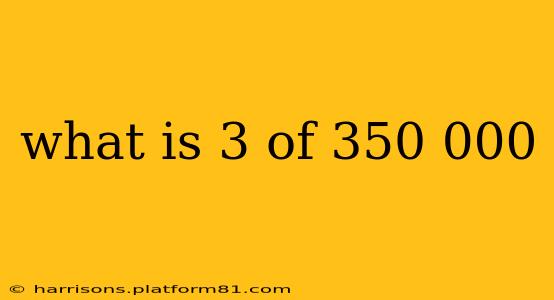What is 3/350,000? Understanding Fractions and Decimals
The question "What is 3 of 350,000?" is asking for the result of the fraction 3/350,000. This represents a very small portion of a larger number. Let's break down how to calculate this and understand its significance.
Calculating the Fraction:
To find the answer, we simply perform the division: 3 ÷ 350,000.
This calculation yields approximately 0.00000857. This is a very small decimal number, indicating that 3 is a minuscule fraction of 350,000.
Understanding the Result:
This result can be expressed in several ways:
- Decimal: 0.00000857 (approximately)
- Percentage: To convert the decimal to a percentage, multiply by 100: 0.000857% This further emphasizes how small a proportion 3 is compared to 350,000.
- Parts per million (ppm): To express this as parts per million, we multiply the decimal by 1,000,000: This gives approximately 8.57 ppm. This is a common way to represent very small proportions in various fields such as environmental science or engineering.
Why is this important?
Understanding how to calculate and interpret fractions like 3/350,000 is crucial in various contexts, including:
- Probability and Statistics: Representing the likelihood of rare events.
- Finance: Dealing with very small percentages of large sums of money.
- Science: Expressing concentrations of substances.
- Engineering: Working with precise measurements and tolerances.
Addressing potential follow-up questions (People Also Ask):
While there aren't specific "People Also Ask" questions directly related to this simple fraction calculation on Google or Bing, we can anticipate related questions and answer them here:
How do I convert a fraction to a decimal?
You simply divide the numerator (the top number) by the denominator (the bottom number). In this case, 3 divided by 350,000.
How do I convert a decimal to a percentage?
Multiply the decimal by 100 and add a "%" sign.
How do I express a very small number in a more understandable way?
You can use scientific notation (e.g., 8.57 x 10-6), parts per million (ppm), or simply round the number to a convenient level of precision. The choice depends on the context.
In conclusion, 3 out of 350,000 is an extremely small fraction, best represented as approximately 0.00000857 or 8.57 ppm. Understanding how to work with and interpret such small fractions is a valuable mathematical skill applicable in many areas.
